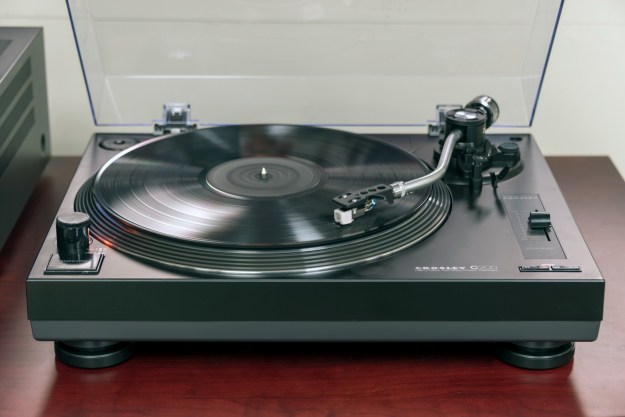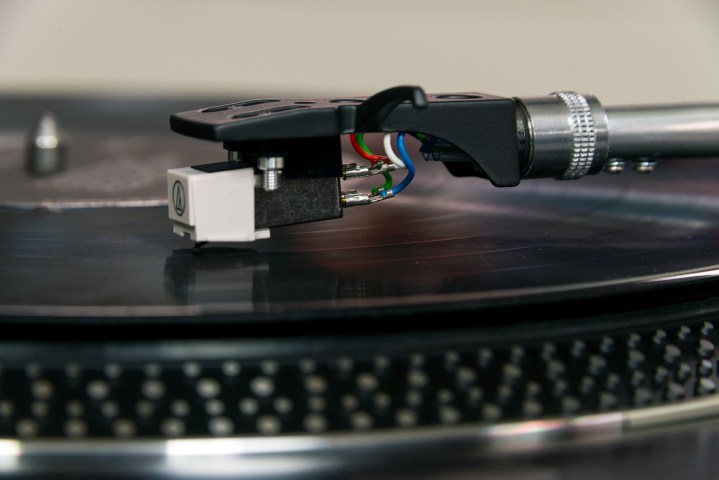
“With a great price and quick setup, the Crosley C200 is a great jumping-off point for beginning vinyl listeners.”
- Solid build quality
- Easy to set up and maintain
- Built-in phono pre-amp makes stereo integration a breeze
- Functional, no-frills design
- Phono pre-amp shows small amounts of distortion at higher volumes
- Included RCA cables are too short
It may seem odd that the world’s largest turntable manufacturer isn’t a household name, but here we are: Crosley Radio is an almost century-old brand currently manufacturing virtually every kitchy vintage-styled table on the market. Chances are, the company made that leather-clad suitcase player your parents bought you at Urban Outfitters a few years ago — the one you presently want to upgrade from.
Until recently, Crosley was content to keep to entry-level turntables and own that market exclusively. But with the introduction of the company’s new C-range of turntables, including the C200 direct drive option, Crosley is stepping into a rapidly expanding segment of low-cost, high-value market, challenging longtime go-tos like the Audiotechnica LP-120.
Out of the box
The C200 comes well-packaged in a large cardboard box, with each separate element of the table protected by various thicknesses of foam and shock-proof wrapping material. Some assembly is required.
Once everything is unboxed and laid out, the main table unit, a plastic dust cover, a die-cast aluminum platter, a tone arm counterweight, an Audio-Technica cartridge, and a short RCA cable must be pieced together. An instruction booklet and plastic 45 R.P.M. spacer are also included.
Setup
Don’t let the fact that some assembly is involved put you off. The C200 is extremely easy to put together – just be sure to follow the included instructions rather than wing it.
The turntable’s platter fits snugly at the center, and the included Audio-Technica needle quickly affixes to a pre-installed cartridge. The only tricky part is installing the tonearm’s counterweight, but the booklet is extremely helpful in describing how to achieve the correct balance. Likewise, the dust cover installation is about as easy as it could possibly be, quickly and intuitively snapping into place.
Once the table is plugged in, all you need to do is patch the RCA cables into a stereo amplifier or phono pre-amp you and power it up via a switch in the bottom left corner of the table.
Features
The Crosley C200 is a solid direct-drive turntable with all the functionality most of us desire. Everything included in the package feels respectably solid and works well, though they certainly aren’t especially high-end components.
The Crosley C200 is a cheap, simple, and good-sounding option.
The C200 looks similar to other classic tables from the likes of Technics and Audiotechnica – much like a Thinkpad does in the world of computing: It is clean, unassuming, and it gets the job done; It’s more of a tool than a showpiece.
Pitch adjustment and both 33 rpm and 45 rpm playback speeds are supported here. Our test model came spinning perfectly with no speed adjustment needed, indicated by the turntable’s strobe speed indicator.
The C200’s tonearm has hydraulic lift control and the same lockable rest you find on virtually any turntable — though we found this one particularly robust. Audio-Technica’s NP5 needle — a $15, Crosley-custom job — is a decent starting option for most, though an upgrade to a better cartridge/needle combo like Audio-Technica’s AT100E, or Ortofon’s popular 2M Red will yield considerably superior sound quality for a relatively modest fee.
Perhaps the C200’s most convenient feature is an its built-in phono pre-amp, which means that those without a phono input on their receiver or integrated amplifier won’t need to need to purchase an outboard phono pre-amp to get listening right away. Crosley has included a simple switch on the back of the C200 to determine whether the built-in phono pre-amp is on or off, making the addition of an outboard phono pre extremely easy. This sheds light on who Crosley is after with the C200: Those who want to upgrade from a cheaper lo-fi table to a fully-functioning model, with the option to implement more upgrades down the road.
The only feature the Crosley C200 doesn’t offer out of the box is an auto-return function whereby the tonearm lifts itself off the vinyl at the end of the record and returns to rest in its peg. We can’t really knock the C200 for that given many turntables — both in this price range and in more expensive options — do not have this function.
Performance
The Crosley C200 sounds great all around. When using the built-in phono pre-amp, highs were crisp, mids warm, and bass — even on particularly bombastic cuts from a coworker’s special 180 gram copy of Kendrick Lamar’s untitled unmastered. — was tight, clean, and never threw the needle from its groove. Vintage records like the gorgeous Clifford Brown With Strings came through with warmth and no jagged edges, despite record label Emarcy’s slightly overdriven 1957 recording style.
We did notice some ruffling of the edges in the form of moderate compression in the upper-midrange, but we only noticed it when we listened at extremely high volumes – the distortion was otherwise inaudible. It’s hard to knock the C200 for this issue, though, as we didn’t expect much from the built-in pre-amp.
When plugged into an outboard phono pre-amp (we used the outstanding and affordable U-Turn Audio Pluto) we noticed a fairly decent increase in overall clarity, indicating a nice place to throw some upgrade dollars when one is looking for increased fidelity. Again, though, the C200’s built in pre-amp is by no means poor, especially considering it comes free inside the deck.
Crosley says that users can expect 1000 hours of playback out of the Audiotechnica NP-5 cartridge, and we have no reason to doubt that — we noticed no loss of fidelity over hours and hours of listening.
Our Take
The Crosley C200 is a affordable, simple, and solid-sounding option for those looking to upgrade from an entry-level turntable.
Is there a better alternative?
Though it lists at $279 on the company’s website, the C200 can be had for around $200 at Amazon, making it a simpler, less expensive option to the much-lauded Audio-Technica LP-120 — a big player in this space (though it is worth noting the LP-120 is a much more robust table with a better suspension and USB output for easy digital archiving.) The Fluance RT80 is another attractive option at the C200’s price level, however it lacks pitch control.
How long will it last?
The C200 is solidly built and should last for many years with limited maintenance thanks to its direct-drive motor and easily replaceable needle.
Should you buy it?
Yes. The C200 is an extremely solid option for those looking to replace a lower-end turntable with something that looks, feels, and sounds like a much higher-end deck. It’s a perfect starting point for a new vinyl listener who is looking to incrementally upgrade their setup. We award the C200 4 stars due to its combination of features, performance, price, and accessibility.









